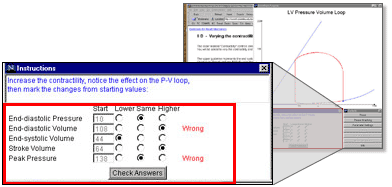|
The Simulator and Exercises for Heart Mechanics
The Simulator models the pressure-volume relationship of the heart and contains numerous parameters that can be manipulated to simulate various conditions and pathologies useful for the teaching and learning of the function of the heart.
The following is an example of one of the basic exercises students perform in the Sciences Basic to the Practice of Medicine and Dentistry course taught at the College of Physicians and Surgeons and the School of Dental and Oral Surgery.
The Heart Simulator provides a continuous graphic output of the relationship between pressure and volume in the heart under varying conditions.
Students are asked to modify the contractility variable within the heart model and observe the effects on the Pressure Volume Loop of the left ventricle in order to answer the questions seen at the bottom center of the screen.

Note how the loop changes as the contractility slider is moved to the right and how the Simulator provides basic feedback when a user submits their answers.
Two examples of Simulator exercises typically used with first-year medical students are provided below for you to experiment with. If you need assistance, try reading the information provided in the Heart Mechanics section. You can also place your cursor over any part of the Simulator and press F1 on your keyboard to get help.
Exercise: How Changes in Heart Rate Affect the Pressure-Volume (P-V) Loop
In this basic exercise you will have the opportunity to change the heart rate and see the effect on the P-V loop. Feel free to try to answer the questions about
the changes you made that are provided in the instruction box. You can also adjust several other variables including contractility, filling pressure, and afterload
and observe the effects.
 Try the Heart Simulator
Try the Heart Simulator
(Recommended browsers: Netscape 4.7x for Windows operating system, IE 5.0 or higher for Macintosh operating system)

Exercise: How Aortic Stenosis Affects the Pressure-Volume Loop
In this more advanced exercise, you will apply aortic stenosis (a failure of the aortic valve to open properly during ejection), to the Simulator and observe the
effects. You can also experiment with other valve pathologies.
 Try the Heart Simulator
Try the Heart Simulator
(Recommended browsers: Netscape 4.7x for Windows operating system, IE 5.0 or higher for Macintosh operating system)
|

